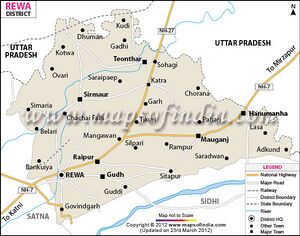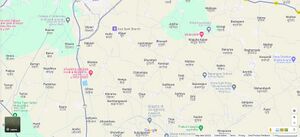Dhurehati
| Author:Laxman Burdak, IFS (R) |


Dhurehati (धुरेहटी) is a village in Huzur tahsil in Rewa district in Madhya Pradesh. Its ancient name was Dhovahatta (धोवहट्ट).
Variants
- Dhureti was place of find of Rewah Plates of the time of Trailokyamalladeva -(Kalachuri) Year 963 (=1212 AD).[1]
- Dhovahatta (धोवहट्ट) (L.10) mentioned in Rewah Plates of the time of Trailokyamalladeva -(Kalachuri) Year 963 (=1212 AD). Dhovahatta (दोवहट्ट) which was a pattana at the time is identical with the village of Dhureti where the plates were found. [2]
- Dhovahatta pattana (धोवहट्ट पट्टन) (L.10)
Jat Gotras Namesake
- Dhur (Jat clan) = Dhurehati = Dhureti as mentioned in Rewah Plates of the time of Trailokyamalladeva -(Kalachuri) Year 963 (=1212 AD). This set of two copper-plates was found in 1929 at Dhureti, a village about 7 miles from the Rewah town, by a cultivator while ploughing his field, and is now preserved in the Treasury at Rewah. [3]
- Dhanoi (Jat clan) = Dhanavahi (धनवाही) (L.10). Dhanavahi pattala (धनवाही पट्टला) (L.10) is mentioned in Rewah Plates of the time of Trailokyamalladeva -(Kalachuri) Year 963 (=1212 AD). The record is a vitta-bandha or 'deed of mortgage' for the village Alirā (अलिरा) (L.14), situated in the Dhovahatta pattana (धोवहट्ट पट्टन) (L.10) of the Dhanavahi pattala (धनवाही पट्टला) (L.10). The village was pledged by the Saiva teacher śāntasiva, son of the royal preceptor (rājaguru) Vimalasiva, to the Rāņaka Dharēka (राणक धरेक) (L.14). Dhovahatta (दोवहट्ट) which was a pattana at the time is identical with the village of Dhureti where the plates were found. [4]
Location
Dhurehati is a small Village/hamlet in Rewa Tehsil in Rewa District of Madhya Pradesh State, India. It comes under Dhurehati Panchayath. It belongs to Rewa Division . It is located 10 KM towards South from District head quarters Rewa. Chua ( 3 KM ) , Khaur ( 3 KM ) , Jokiha ( 4 KM ) , Kothi ( 4 KM ) , Dihiya ( 5 KM ) are the nearby Villages to Dhurehati. This Place is in the border of the Rewa District and Satna District. Satna District Rampur Baghelan is west towards this place .
History
Trailokyamalla was a son of the Kalachuri king Vijayasimha, as attested by the 1193 CE Jhulpur inscription, which records a grant made on Trailokyamalla's birthday. Vijayasimha's reign ended around 1210 CE.[5]
Information about Trailokyamalla's reign comes from a 1212 CE (963 KE) inscription discovered at Dhureti in Rewa district of Madhya Pradesh. The inscription, which records a village grant, mentions the traditional high-sounding imperial Kalachuri titles for Trailokyamalla. The find spot of the inscription suggests that he retained the territories that he inherited from his father. The inscription also calls him the lord of Kanyakubja (modern Kannauj): in absence of any corroborative evidence, it is not certain if he actually managed to capture Kanyakubja.[6]
Notable persons
External links
References
- ↑ Epigraphia Indica, Vol.25, 1939-40,pp.1-6
- ↑ Epigraphia Indica, Vol.25, 1939-40,pp.1-6
- ↑ Epigraphia Indica, Vol.25, 1939-40,pp.1-6
- ↑ Epigraphia Indica, Vol.25, 1939-40,pp.1-6
- ↑ V. V. Mirashi (1957). "The Kalacuris". In R. S. Sharma (ed.). A Comprehensive history of India: A.D. 985-1206. Vol. 4 (Part 1). Indian History Congress / People's Publishing House. ISBN 978-81-7007-121-1.p.496
- ↑ V. V. Mirashi 1957, p. 497.

